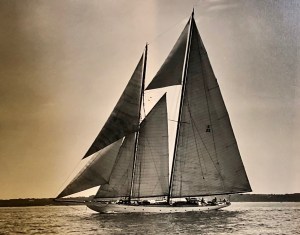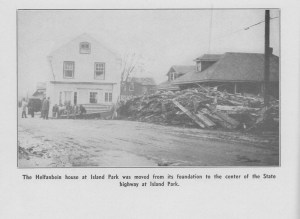
Portrait of Vanderbilt at MarbleHouse
A very simple, flat gravestone in St. Mary’s Churchyard marks the final resting of place of Harold Stirling Vanderbilt. Vanderbilt (known as Mike) was a railroad financier and great grandson of Cornelius Vanderbilt. Despite his family background and business, Harold was best known for two passions in his life – The game of Bridge and Sailing.
Vanderbilt was a three time defender of the America’s Cup – sailing’s great race. He nearly lost his yacht, the Vagrant, in a twist of fate in 1914 during the beginning days of the First World War. As the Commodore of the New York Yacht Club, Vanderbilt sent his yacht from Rhode Island to Bermuda to meet the British competitor – Shamrock IV and escort it to Newport. When Britain declared war on Germany on August 5, 1914, the British crew received word by radio. The Vagrant had no radio and was unaware of the declaration of war. One of the first things done in Bermuda to prepare for war was to remove all navigational aids. The crew of the Vagrant did their best to work through the narrow channel and barrier reef without the aid of the buoys and markers. They found themselves directly in front of St. David’s Battery where the gunners were prepared for war and opened fire. Luckily it was a warning shot! The America’s Cup was cancelled for that year.

Photo of the Vagrant (Marble House)
Harold Vanderbilt saw active duty when the United States entered World War I. He was the commanding officer for the scout patrol out of Newport and later was in command at Block Island. He was then placed in command of an anti-submarine force in New London. He was reassigned later to command the Block Island, Rhode Island, anti-submarine sector and then the New London, Connecticut sector. In 1918 he was reassigned to a Submarine Chaser Detachment in Ireland and served there until after the Armistice was signed.
When World War II began, Vanderbilt’s yachts Vagrant and Vara were appropriated by the US Navy. Vanderbilt received a check for their value, but he signed it over to the USO so the money would benefit servicemen.
Harold Vanderbilt is known as the originator of contract bridge. In 1925 he was on a slow boat to Havana and was bored by the card games that were dependent on luck instead of wits. He retired to his stateroom to work on a game that would rely more on intellect. A few hours later he devised a game based on whist and auction bridge. He had players bid games and slams. He worked on a scoring system that rewarded good judgment and penalized players who failed to make bids. He tried it out on his fellow travelers and the game caught on.
If you want to know more about Harold Stirling Vanderbilt, you can view items from his military service and yachting career at the Marble House. In 1963 Vanderbilt bought back the Marble House which his mother had sold thirty years before. He turned the building over to the Preservation Society of Newport County.
Sources: “Vanderbilt’s Card Game: A mirror of modern society” An article in the Washington Post, March 1, 1981.
Wikipedia article on Harold Stirling Vanderbilt :https://en.wikipedia.org/wiki/Harold_Stirling_Vanderbilt
